In this new article, we talk everything RankBrain and how to optimize for RankBrain!
Let’s get started.
I am sure you’ll agree with me:
Google‘s ranking algorithm is insane.
Not only that, but it’s getting more complex as new layers of technology are added to it regularly.
It’s gotten to the point that even the folks at Google don’t quite understand what is going on.
What are we as marketers to do?

Well, first we should name the beast, and I recommend the word- Google 1001- If it catches on, remember whence it came.
Their newest major algorithm addition is RankBrain
- What RakBrain is?
- What does it do?
- What do you need to do to optimize for RankBrain?
These are all the questions covered in this article.
And I also have a strong finish with some awesome actionable tips for you.
No doubt you’ll be able to turn RankBrain into your greatest ranking weapon.
Let’s go!
What is RankBrain Exactly?
So what is RankBrain? Well, it is an artificial intelligence program patented by Google.
It works in conjunction with the main algorithm (Hummingbird) to deliver better SERP results.
Yeah, but how does it work exactly?
I don’t know.
I am neither an engineer nor a technical kind of guy.
But I can tell you this:
RankBrain is just a nickname.
It has some kind of fancy scientific name, but it’s nicknamed “the Brain” because it does what every brain excels at, it learns.
Yes, machine learning is now a thing.
Google RankBrain has been with us since 2015 when it was first unleashed on the SERPS.
This is how SEO niche experts think it works:
Let’s say I search for “what is the best coffee to drink while vacationing in Ethiopia”.
This is a long-string query normal algorithm isn’t adept at.
It will try to find an exact match and its closest approximates.
But in most cases, it will fail.
So, I click on the first result, nope. Not good.
Second? Also not good.
Third? No!
Fourth? Yes, this one is decent, not great though.
So I try several results and barely found a serviceable one
Not good Google.
You can do better.
And so it does.
And that’s what RankBrain is all about.
It observes and takes note of my behaviour as a searcher for this particular keyword.
Then, next time RankBrain is updated, this newly gathered intelligence is added to the main algorithm (for that one keyword).
This entails that next time someone searches for “what is the best coffee to drink while vacationing in Ethiopia” the results will be different.
How different? And by how much?
Once again – I don’t know. No one does.
My guess is that those first three results (which were not that good) will be pushed down, while the fourth will come out on top.
And before you start nitpicking about the phrase “gather intelligence” being spy lingo and not suitable for the post about SEO.- think about this for a moment: RankBrain is everywhere.
Everything you type in Google search box today is being spied on.
Think about it.
RankBrain Misconceptions
We are nearing to the crux of the article- How to optimize for RankBrain?
But before that, I think it’s worth your time to briefly read up on some common RankBrain misconceptions.
These are the ones I handpicked up while lurking on the forums.
a) RankBrain works in Real Time
Just by hearing about the concept of the machine that learns and updates itself, you’d think this is a given.
But it’s not.
RankBrain, at the time of me, writing this is still manually updated by Google’s engineers.
However, the prediction is that over time it will become autonomous.
Or as it is called it the robotics lingo- a deep learning machine system.
This means that it will be able to learn on the fly and implement in real time.
As for the SERPS?
They’ll be in constant flux.
Kind of scary don’t you think?
But it’s nothing new.
The same thing happened with Google Penguin.
In the beginning, it was updated quite often, then it slowed down.
Now it’s real-time, which means that it is always working behind the scenes, always on a hunt for bad links.
b) It’s a New Algorithm
No, it’s not.
It is only the latest addition to the main algorithm(Hummingbird).
The same as any other new ranking factor (SSL for example).
The difference here is that RankBrain has become crucial to the search results.
So crucial that someone at Google said: “Turning off RankBrain would be like deindexing half of Wikipedia“.
c) RankBrain messes with ad placements
That is not true.
PPC’s are exempt from RankBrain’s influence, and from all other ranking factors too.
Think about it.
You are paying Google for your top spot then they can’t gamble with your money.
Bottom line– Ads are untouchable.
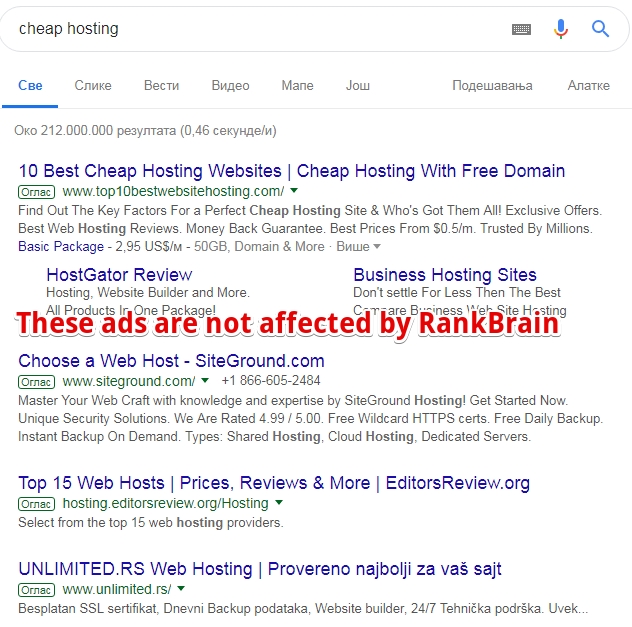
Also, I’ve read somewhere a funky theory that if you’re heavily into PPC, Google will somehow favour you with better rankings for all keywords and that RankBrain is designed to reward you for it.
There isn’t a grain of truth to this.
You have nothing to fear if you aren’t spending a fortune on ads.
Your content is what gets you on the brains radar.
Great content is what optimizing for RankBrain is all about nothing else.
d) Social Shares influence RankBrain
Google is clear- social share counts are not part of the ranking algorithm.
There are two reasons for this
- They can be easily gamed
- Google doesn’t have full access to the data(think: Google Analytics).
So no matter how many likes and shares your site or page gets it won’t influence the brain one bit.
e) RankBrain is English Only
Google in other languages operates the same as in English.
So, all ranking factors are shared between them, including RankBrain.
If you’ve hoped to avoid it by making your blog in your native tongue, instead of in English, tough luck friend.
But then again- there’s no reason to fear RankBrain either.
I will soon show you how to optimize for RankBrain
How Does RankBrain affect your SEO strategy?
I bet you’ve been waiting for this.
You, the marketer, must know how it works so you can adapt, so you can thrive, score big, win the game (choose whatever metaphor suits you best- you want to become rich).
Rank Brain reformed SEO by strongly reinforcing what Google as a search engine is all about:
Delivering the right content to the right people.
Now:
You might be wondering “am I not writing quality stuff already, how can I do any more than this”?
My guess is that you are doing your best, but with sloppy execution.
Hey, it’s not your fault…
Earlier, every half-decent SEO put out decent content did superb SEO and ranked, and ranked well.
But with RankBrain, standard SEO is no longer enough and decent content is less than enough.
But there is a way around it
Here is the best approach to take, the blueprint:
It starts and ends with keyword research
Not all keywords are made equal.
When deciding on the phrase to pursue, and after you’ve checked for competition and traffic numbers, you also need to gauge the user intent behind the keyword.
This is crucial.
Because:
you’ll be writing fewer articles from now on so each one must hit that sweet spot between large-enough traffic and big-enough commercial intent.
Your job as a marketer is to find the topic (keyword) you want to talk about, find related topics, and use them to enrich your article and make it more useful.
I recommend you use the system I call “Head and Subhead”.
Your head is your main topic/keyword.
Your subheads are your additional topics/keywords.
But this doesn’t mean sprinkling keywords hoping to rank for exact matches.
RankBrain optimization demands content that answers the question.
This means each keyword you use should be expanded upon.
Now:
You shouldn’t go wild either.
Two or three short paragraphs per topic are more than enough.
That is topic coverage at an optimal level.
Just make sure when writing that every subhead ties in tightly with the main topic/keyword.
Think of your article as a human body.
Can a body function without a head? No!

Can it function with just a head? No!
But in SEO it used to be so until recently (until 2015 when Google updated its anatomy knowledge- hint- it’s RankBrain learning anatomy).
Now your articles need to have a head (main topic), two arms two legs, abdomen, heart, liver…
As for the soul, you can’t create one but you can pour your own into your writing:-)
I’m confused. What should I write about now?
If you’ve decided to pursue quality over quantity (and you should’ve) then at some point you will have a problem – too many topics for just one article.
When it happens – you’ll need to prioritize.
Think about the reader.
Think:
“How will he benefit if I include this paragraph about x”?
“If I exclude it, will he be left with incomplete knowledge”?
“Will he have to go elsewhere to get the info”?
For example:
Let’s say someone searches for “how can I start running to improve my health”.
Now I ask you the marketer to wait (and you were just about to sit and type your winning 500-word piece, “3 awesome tips for healthy running”)
Ask yourself:
Does this person only want to know the basics (keep your head up, wear comfy snickers, carry a water bottle …)? Or maybe something more?
In my mind this person is also interested in:
- How to start running if they’ve led a sedentary lifestyle?
- How much is safe to run every day?
- When is the best time to run?
- Should they run with a friend or not?
- Should they drink mineral water, or enriched? (I’ve read about chia water that gives you extra strength for prolonged running)
And there’s probably so much more.
You don’t have to cover everything under the sun.
Just make sure you know the likely and crucial questions in your reader’s head, then give thorough answers to them.
Leave no stone unturned and your reader will thank you for it.
So, in this example your head topic was “how to start running” and those bullet points from the above were your subheadings.
Now this kind of an article Google will trust and will want to rank.
And it will hunt you down for it 😀
Another example is this very article you’re on.
The keyword is “optimize for RankBrain”.
It isn’t a particularly “rich” keyword.
I could’ve said what it is when it was invented, what it does and ended it with a general recommendation- write better content.
And no old-fashioned marketer would’ve blamed me for it. Hey, it works, why change? Except that nowadays it doesn’t work.
Instead, I covered:
- What RankBrain is
- RankBrain misconceptions
- RankBrain best practices
- How to optimize for RankBrain
- Topic research vs keyword research (this is next)
This article extends to 4000 words without me having to try.
It is like that because I chose to include several subtopics that could have easily been short articles on their own.
This is the new approach to content marketing – write less in number-cover more in substance.
Do My Articles Always Have to be so Long? Will Shorter Never Rank?
Your articles have to cover the topic well, but that doesn’t mean they have to be very long.
It depends.
Some topics don’t deserve the 2000 word treatment and you should never extend your piece just for the sake of it.
The article CAN be short and still rank well.
For example:
I once wrote an article: “how to get a dofollow link from Youtube”(note: that site is offline now)
A short 500-word piece would have been sufficient to explain it well.
But I chose to include additional information like:
- What are nofollow and dofollow links?
- How to check which link is nofollow?
- How to add a nofollow tag to a link (both with a plugin and manually)
That was a very comprehensive article it didn’t take long for it to enter the fray for number one spot in Google.
And it was only 1400 words.
Bottom line– Shorter articles can rank well in the right circumstances.
How to Know Which Topics to Cover in an Article (keyword research done right)?
You could use common sense.
But you could also ask Google. And I recommend it.
This is how to do it:
We’ll use the Moz keyword explorer.
Go to: https://moz.com/explorer For demonstration, we’ll use “begin running overweight”.
Because using Google Suggest I discovered people type in this keyword quite often.
Of course, we’ll change it a bit to have it make human sense.
Once you’ve typed your keyword you’ll be taken to another page.
There you’ll need to set some parameters.
On the left you have:
- Overview
- Keyword Suggestion
- SERP Analysis
Choose the second option
Now that you have a list of keywords you need to filter them by choosing:
- Based on broadly related topics and synonyms
- Yes with low lexical similarity

Now you have a list of keywords but each list has a list of its own.
The main one is your blog topic/keyword you should target.
The second list are the topics you should cover in the article to make it a living body.
Here is what I mean:
Our keyword “begin running overweight” has given us four subtopics to work with.
Four keywords = four short blog posts.
Or,
if you want to please RankBrain- four subheads.
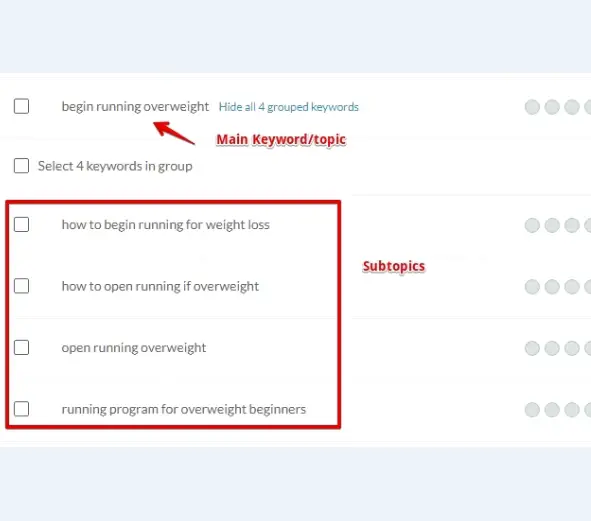
Here’s how I would do it:
Introduction-So you’re overweight and want to start running to improve your health?
Good for you because running is a healthy habit to have, and a perfect way to lose excess weight AND improve your health…
How to begin running for weight loss
When you have a bit of extra weight lying around doing nothing, you’ll want to remove it ASAP.
But it is essential to start slow.
Trust me, you don’t want to overexert yourself and have a medical emergency.
I’ve seen that happen to a young guy who thought he was fit.
Start slow and you will run far and lose weight in the process…
How to do open running if overweight
To be or not to be- this is “the question”. But not today.
The real dilemma is: open running or on a treadmill.
On the one hand, it is pleasant to go outside, breathe fresh air, catch some natural vitamin D.
But on the other, running on the treadmill is safer.
You can’t fall and hurt yourself, especially if you’re in a gym surrounded by folks who can keep an eye on you and motivate you…
Running programs for beginners
Running alone is loads of fun, but sometimes it is not very effective.
It’s not your fault as there’re techniques to running efficiently that only a licensed instructor can teach you.
Yeah, like with everything else, life is complicated even at the running part.
Conclusion– Running is extremely healthy and you should try it.
If you aren’t sure how to, consider joining an official course.
You’ll have to pay for it but it will be so worth it.
I recommend this one (affiliate link)
There you go.
This article would be thorough, and it’d cover many topics Google considers relevant.
And you’d have a chance to earn affiliate commissions from it for a very long time if it ranks of course.
But will it rank?
Nothing is ever guaranteed, in life or in Google,
But,
built like I just showed you, it has the best chance to break through the noise, and you have something to hope for.
Join the conversation - We are talking How to optimize for RankBrain and more!Click To TweetBonus – How to Optimize for RankBrain
I’ll be honest.
The tips from above apply to both Hummingbird and RankBrain algorithms.
It’s because they work in conjunction.
And no, I didn’t forget to mention that to you; I purposely omitted the fact because I wanted to help you kill two birds with one stone; feed two birds with one grain (I’m vegan).
But I still feel the need to mention the RankBrain-exclusive tips for higher rankings.
Enjoy!
RankBrain is all about UX signals and catering to the will of the people.
If you can get on the good side of searchers you’re guaranteed to rank high, even if you have fewer links than your competitors.
It’s because links are easy to game and UX signals are near impossible to fake.
Which are UX signals exactly?
They are:
- CTR
- Pogo Sticking and dwell time
- Bounce rate
Let’s break down real quick how to boost each of them for your site.
1. CTR (Click-through rate)
This is something you’d want to do, regardless of SEO.
Improving CTR is not only good for SEO, but the simple fact that more people consume your content means that more people will be exposed to your money links with some of them clicking and buying.
So higher CTR=more money.
And there’s not a single reason why you wouldn’t want higher CTR for yourself.
a) Make your Meta title magnetic
Meta title is not the title of your post, but the SEO title that appears in the SERPs, and you want to make it appear magnetic.
The easiest way to do it is to include power words within your title.
What are power words?
They’re those that convey that the goal will be achieved easily and speedily. Because people on the web are in a hurry and they don’t like to waste time or time wasters excuse of a site. So including power words is a surefire way to get their attention, FAST.
Some examples are:
- Fast
- easy
- incredible
- insane
- learn
- See for yourself
- Destroy
Those were just samples, and here’s a huge list of them.
Camel case your title, or don’t;
What is camel casing?
Camel Casing is Making Each Letter at the Beginning of the Word Capitalized (Like This).
Whether you should do it depends entirely on your competition. if they’re all doing it- then you shouldn’t; If they aren’t- you should.
The goal is to stand out.

b) Meta description- describe your post
Meta description lies right below your SEO title. And in some ways it even more important than the title. Because you get to use more words you can say much more.
But the rules stay the same- Make people understand that if they don’t click… they’ll be sorry.
Content table give you site links
Have you noticed that Wikipedia results often have a bunch of link beneath them?
like this
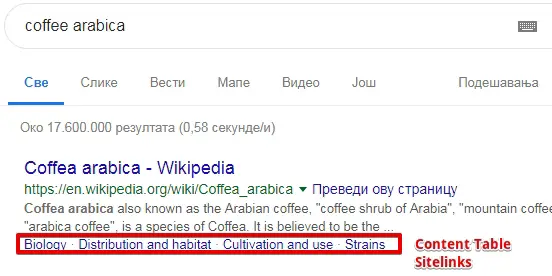
Those are called sitelinks… and they’re totally replicable. You don’t have to be Wikipedia to have one. But you do need to have a table of content at the start of your post or page.
Then Google will automatically extract it to show the user that your site is a good fit for your query.
For example:
here, my SiteRubix review ranks on the first page for the query “siterubix site speed” and Google shows site links under my snippet.

2. Pogo Sticking
Ahh, the bane of every honest webmaster.
What is pogo-sticking exactly?
It’s when people land on your site and then quickly leave. This means you offer terrible UX and/or your content is irrelevant. In any case, if you don’t fix it your site will be destroyed and no amount of links can help you.
Pogo sticking is a problem that has to be solved on two levels
- Site level problems
- Page level problems
Page problems are things like content relevancy, content formatting and using images, which I cover below when I talk about improving dwell time.
Site level problems are those that make people want to leave right away. And it’s a shame if they do.
Instead, let’s make your site a fun place to be at
Site speed- make it fast or nothing
Today, slow site=dead site.
Folks are not willing to wait, one second more is one second too much.

Fortunately, you can fix it with minimal expenses.
Here are 3 easy ways to do it:
a) improve hosting
Slow hosting is the number one culprit for a snail-like site.
And it is the first thing you need to fix if you hope to rank well. Really it is, though I know you’d rather not spend money that you don’t have.
But it’s a necessity and it’s an investment. If you’re building an online business, fast hosting is a must. But once you have it then all other things you do will be greatly amplified
Examples of a fast host are
- Bluehost
- WPX Hosting
- SiteGround
- Kinsta
b) image optimization
This is the second biggest culprit. Images make up the bulk of your site’s weight and by reducing their size you’d be throwing away the heaviest stone first. Your pages will performer better site will be faster you will breathe freely again.
How to Optimize Images?
If you’re on WordPress I recommend plugins (WP Smushit is both automated and free, great hassle-free option)
If you have a free site, then there are fee online tools you can use, for example, PicResize. (read my tutorial on Quora).
c) mobile friendly
Mobile search is so prevalent that I feel it’s redundant to even speak about it.
But I’ll still talk about it.
If your site is not mobile friendly-make it so. The world is going mobile, move or be left behind.
The choice is yours.
3. Dwell time and bounce rate
Dwell time is the amount of time folks spend on your site and specific page.
You want that time to be astronomical, not just because of SEO, but because a visitor who stays and reads is the one that can be sold on later, and the one who is going to become your brand’s evangelist in the future.
Because they obviously enjoy being on your site.
Here are three time-tested tactics to do just that.
a) the three musketeers technique
The power trio is:
- A mighty Headline
- An underwhelming into
- an interesting/enticing image
Here’s the example from this very post:
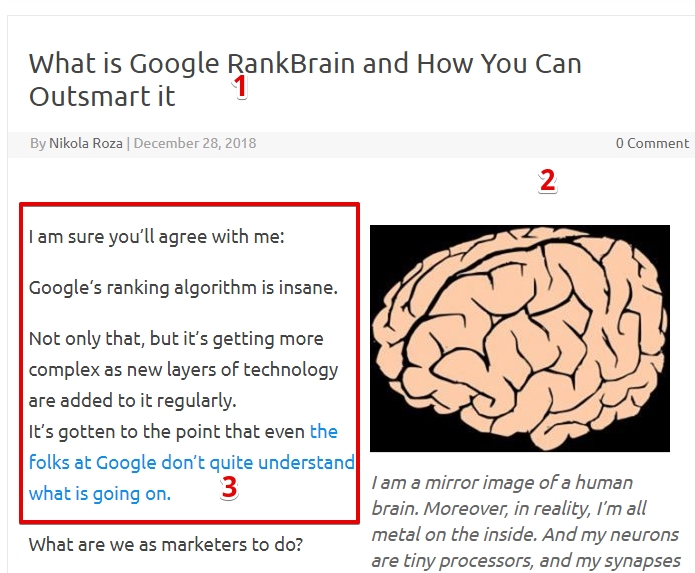
Remember, your main goal is to draw people to read your post. And this technique helps a bunch.
b) strategic internal linking
In theory, all your content is worth looking at and I know you’d rather have a reader on ANY page on your site than off your site.
So to accomplish it you should use strategic internal linking.
What do I mean by “strategic”?
I mean that links at the beginning of the spot are much more likely to be clicked
So have an internal link at the beginning of a post. Then you know that even if people don’t read the post they’re on, they’ll still be on your site.
Think of it as your second chance at converting them.
c) Content table
Table of content at the beginning of your post/page is an excellent way to draw people in.
They help pull people into the part they’re most interested to readers. And when they do they read time passes and your page dwell time increases. And RankBrain notices and gives you bonus points.
Optimize for RankBrain – Bounce Rate
What is it?
Bounce rate is when people leave after they’ve been on just one page on your site. It doesn’t matter if they were reading for 30s; or 30m. A bounce is a bounce.
Yes, but is it a ranking factor.
Probably not.
Because people can learn what they need on your page and then leave satisfied, but how will Google know that?
But you still want people to stay for as long as possible because it’s good for business.
The best tip I can give you and one that will always work, no matter what is…
make awesome content
How helpful is that:)
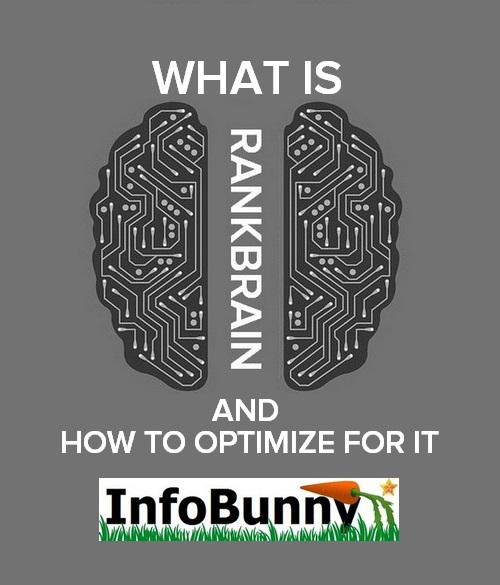
Conclusion- Google RankBrain- friend or foe?
RankBrain is here to stay.
And it’s only going to get better at its job.
You can close your eyes and pretend it’s not there.
Or you can do something about it.
I suggest the latter.
It all boils down to better content and I’ve just shown you the right path to take.
Yes, it will be harder, but do it right and results will come and they’ll be nothing short of extraordinary.
Thank you for reading.
Please share if you liked the article
And leave a comment below.
Did you already know this stuff, did you know how to optimize for RankBrain?
Has RankBrain affected you in a negative or a positive way?
Tell me because I’m curious to know.
You’re awesome for reading and I, Nikola, am signing out 🙂
Related Articles
Cybersecurity Risk – What’s your strategy for Cybersecurity?
How to secure your WordPress site [Guide]
Mobile SEO Guide 2021 – The Ultimate Guide
How to find orphaned content






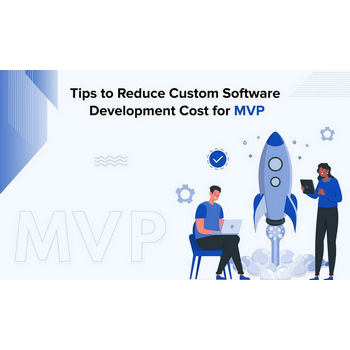

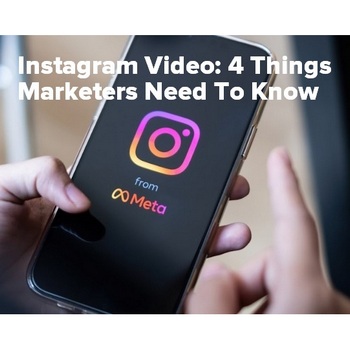


Lisa Sicard
Hi Nikola, Wow, I had to read through this article twice to really get it but I sure do now 🙂 I have been updating a lot of old content on my site with this in mind but did not know it was called rankbrian. I’m doing a lot of internal linking from orphan content. A bunch of it happened when I went from http to https over a year ago.
Thanks for all the tips here and a thorough explanation of RankBrain.
I appreciate the mention, another older article I need to update btw!
Lisa Sicard recently posted…Inspirational Ideas For Entrepreneurs Who Want To Make A Difference
Nikola Roza
Hey Lisa, I’m glad you liked it and found it useful. I did my best, but the article is far from perfect…
As for your content, I didn’t read through your entire site as you have hundreds of blog posts already published; but the articles I did read are all really good.
They’re already RankBrain-ready:)
Thanks for commenting, Lisa
Ronald Segura
That was an excellent article Nikola.
As you already emphasized multiple times here. All Google wants is just to serve the best content available to answer any searcher’s queries and questions.
That leaves us, as marketers, with only one option, make sure to provide the most in-depth content to our readers on every single article we write.
It’s all about quality now, it doesn’t matter how often you publish new content, or how many articles you have on your site, the quality of your content is the only thing that really matters, besides backlinks, which is always an important factor, but again, quality beats quantity here as well.
One piece of advice I’ll provide to those who have many short articles covering related topics in their blog, is to simply merge them all into one single article and set 301 redirects from the old URLs to the new ones.
This would be a way to take advantage of their existing content and get some RainkBrain love too.
Thanks for the mention Nikola and Dexter,
Cheers!
Ronald Segura recently posted…How to Use Google Search Console to Boost Your SEO – The Full Guide for 2019
Nikola Roza
Hey Ronald, thanks for complimenting my article, it means a lot.
And thank for your 301 redirect tip. You’re absolutely right. There’s no need to waste the articles already written.
Redirect them and any SEO points they had will be transferred to the hub/mother article
Thanks for commenting, Ronald:)
Janice Wald
Hi Nikola,
Thanks so much for linking to my post. I’m happy you feel my article about backlinking errors will be valuable for your readers. I’m off to share!
Janice
Janice Wald recently posted…7 Best Site Speed Tools: 12 Days of Christmas Day 4
Nikola Roza
Thanks Janice,
Your post deserved the link, as it’s both insightful and easy to read and understand.
And thank you for spreading the word about this article
Kyra Rodriguez
Good read! This just answered all the questions in my head right now! I’m actually having a hard time to rank my website, and to adjust in the new google ranking. Thanks for this thorough explanation! Keep it up!
Kyra Rodriguez recently posted…The Advantages of Having a WordPress Survey Plugin
Nikola Roza
Hey Kyra, Ranking in Google is getting more complicated. And the only thing we can do is learn and adapt.
And RankBrain, as the third most important ranking factor for Google , is a big part of that ranking puzzle.
Hang in there…
Bluetechno
Awesome article. Didn’t know about RankBrain, thanks for the explanation Nikola! Gotta love those infobunny’s articles. Every article better and more informative than the previous one. I think if your site is mobile friendly then you are ahead of the competitors.
Bluetechno recently posted…TV-TWO, Webtalk, Bitdegree Review
Nikola Roza
Thanks for the kind words, I id my best, though the article is not perfect by a long shot.
You’re right, The world is going mobile and being mobile friendly has become a MUST.
It’s no longer a choice.
Milon
Awesome article! I have learned and I ‘m sure others will surely learn many things from this article. Thank’s for share us these amazing article. Thank’s a lot. Thank’s.
Nikola Roza
Thanks Milon. I’m glad you enjoyed it and that you learned a thing or two in the process.
There’s nothing better than that…
deepika
nice post thank you
Jasweer
good article.thanks for sharing
Best Quality PVAS
Wow! Useful Blog I have ever seen. Thank’s to share.
gomathi M
Very nice your posting all peoples like this articles thanks for the sharing very good important lines is using this words all peoples like it then using in life good keep it up
Digital Aroma
What is Google RankBrain And How Can You Outsmart It? – Found to be unique article in recent times.
Ranjeet Sharma
Hi,
Great stuff buddy.
Great post, I have read this post here I got very useful information. This is a very useful article for online review readers. Keep it up such a nice posting like this. I started a Blog and Hopefully, it will be successful like you.
Thanks for the share.
Ranjeet Sharma recently posted…Technex 2019, IIT BHU, Annual Techno-Management Fest
Tania22
Thanks for the article. This is really very helpful. I have already archived the article.
Mudassir
Hi Nikola,
Indeed, another helpful article on improvising SERP results.
After reading this article, my mind says to use RankBrain. However, I still prefer Quality over the quantity in article writing,
I’m happy that this strategy is working well for me.
Mudassir recently posted…How DomestiQue Is Started In The College By Students And Growing To The Cities
Vince Comfort
Very true. I’ve actually been a culprit of short posts. But many pillar articles I’ve done for clients do pretty well. Guess I need to start giving more time for my own posts. 🙂
Digital roy Academy
very informative. keep up the good work:)